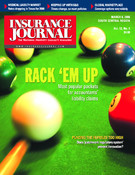According to a new report released by GE Insurance Solutions, massive growth along the nation’s coastlines has dramatically increased the potential for insured losses, even without a cyclical increase in the frequency and severity of hurricanes.
In a paper entitled “Coastal Warning: The Rising Costs of Hurricane Frequency and Severity,” co-authors Kenneth Slack, senior underwriter, Global Property Catastrophe Reinsurance, and Larry Spoolstra, chief underwriting officer for North America and Asia Pacific P&C Reinsurance, at GE Insurance Solutions, wrote, “Demographic trends in Florida and other coastal locations as well as the likelihood of increased frequency and severity of storms should remind the (insurance) industry of the growing exposures it will continue to face. The cost of hurricanes will rise–sooner or later surpassing even those of Hurricane Katrina.”
The authors note that the insurance industry was actually fairly well prepared for such an intense and destructive storm, but not necessarily for a series of them.
According a news release announcing the study, Slack and Spoolstra believe that “the industry is well capitalized and is able to withstand monster storms and earthquakes with insured price tags in the range of $60 billion to $120 billion.” However, they question whether “the industry’s capital providers would continue to maintain sufficient levels of support going forward if a heavy natural catastrophe season occurred during the same year as an unexpected loss, such as the Sept. 11, 2001, terrorist attacks.”
The paper advises the insurance industry to “to keep a perspective on the high level of risk it faces,” in light of the increasing severity and costs of catastrophic losses.
Recognizing the dent recovery from a major hurricane, or multiple hurricanes, would put in the state’s general revenues, the Texas Windstorm Insurance Association, the insurer of last resort along Texas’ Gulf Coast, is trying to increase awareness of the potential risks faced by the state’s heavily populated coastlines while stressing the need to bump up the Texas catastrophe trust fund. Currently not exempt from federal taxes, TWIA will be asking the state legislature to revamp the association’s rules so that all members of the Board of Directors are appointed by the insurance commissioner, in order to comply with Internal Revenue Service rules for tax-exempt status. It also will be recommending that lawmakers establish a method by which pre- and post-event revenue bonds may be used to increase amount of money available in the state’s catastrophe fund. (See story on page 10.)
Since 2006 is predicted to be another active hurricane season, and some suggest that we are in the throes of a multi-year cycle of active seasons, it make sense to keep the warnings in mind, and prepare for the worst and hope for the best.
Topics Catastrophe Texas Hurricane
Was this article valuable?
Here are more articles you may enjoy.


 Litigation Funding, Other New Laws in SE States Could Impact Liability Insurance
Litigation Funding, Other New Laws in SE States Could Impact Liability Insurance  Stepbrother Suspect in Cruise Ship Death Says He Doesn’t Remember Anything
Stepbrother Suspect in Cruise Ship Death Says He Doesn’t Remember Anything  Aon Extends Employment Agreement With CEO Case
Aon Extends Employment Agreement With CEO Case  Howden Buys M&A Insurance Broker Atlantic Group in US Expansion
Howden Buys M&A Insurance Broker Atlantic Group in US Expansion 


